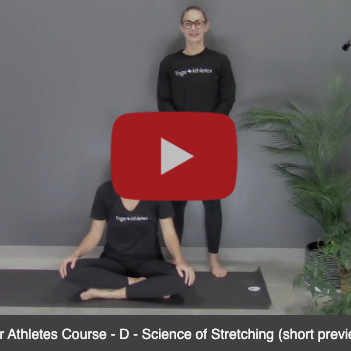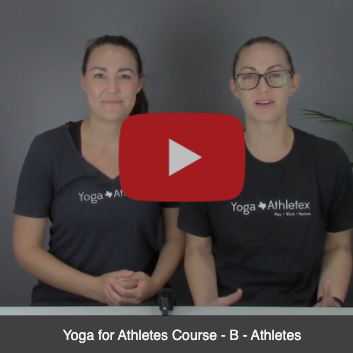Latissimus dorsi in Latin means, “widest back muscle ”. The latissimus dorsi muscle, or lats for short, is a back muscle that extends from our iliac crest (waist) all the way up to our axilla (armpit).
When engaged your latissimus dorsi is responsible for helping you extend, rotate, and pull your arms in towards your body.
Tight, or overactive, latissimus dorsi muscles cause your shoulders to curve forward, pulling your back out of alignment and pushing your chest in. You can counter this tendency by keeping your shoulders down and should blades back as you go about your daily activities. Overactive latissimus dorsi can also cause a potential injury to your rotator cuff and prevent correct posture for handstands, back bends, and down dog. Weak latissimus dorsi can cause your torso to collapse and shoulders to creep towards your ears in up dog.
The latissimus dorsi is not a muscle that gets used much in day-to-day activities so you as an individual should focus on incorporating different latissimus dorsi exercises to strengthen and lengthen this muscle. Many of us have a hard time making it to the gym so down below I have listed and explained in detail some exercises, yoga poses, and a stretch you can do at home that will strengthen and lengthen your latissimus dorsi.
Strengthening The Latissimus Dorsi
Latissimus dorsi pullovers / Lat pullovers
Start out by lying on your back with a household weight in both hands (wine bottle, laundry detergent, laundry basket, etc.) and hold it above your chest both arms extended out towards the ceiling. Keeping your arms straight and engaged, slowly lower your arms back over your head as if you are going to place the weight down behind you. Pull the weight back over your chest, making sure you are engaging your latissimus dorsi the entire time.
*Start out by doing 3 sets of 8 reps and progressively work your way to higher reps
Bent over rows
To perform a bent over row, you start standing with your feet pointed straight ahead about shoulder width apart, dropping your chest towards the floor slightly (30 degree angle), making sure you keep your back flat. If you have dumbbells at home use them, if you have a paint bucket or even two full bottles of wine use that as weight! With weights in each hand, fully extend your arms down towards the ground, slowly lift the weights upward toward your ribs, and lower back down.
*Start out by doing 3 sets of 8 and progressively work your way to higher reps
Downward dog
Begin on your hands and knees (tabletop). Align your wrists directly under your shoulders and your knees directly under your hips. The fold of your waist should be parallel with the top edge of your mat. Spread your palms, index fingers parallel or slightly turned out, and turn your toes under. Exhale and lift your knees away from the floor. Bring your body into the shape of an “A.” At first keep the knees slightly bent and the heels lifted away from the floor. Lengthen your tailbone away from the back of your pelvis and press it lightly toward the pubis. Against this resistance, lift the sitting bones toward the ceiling, and from your inner ankles draw the inner legs up into the groins. Then with an exhalation, engage your quadriceps and stretch your heels down towards the floor. Straighten your knees but be sure not to lock them out. Firm the outer thighs and roll the upper thighs inwards slightly. Broaden across your collarbones. Rotate your arms externally so your elbow creases face your thumbs. Draw your chest toward your thighs as you continue to press the mat away from you, lengthening and decompressing your spine. Align your ears with your upper arms. Relax your head, but do not let it dangle. Gaze between your legs or toward your navel (bellybutton). Stay in this pose anywhere from 1 to 3 minutes. Then bend your knees to the floor with an exhalation and rest in child’s pose.
Dandasana with lift
Sit on the floor with your legs together and extended in front of your torso. If your torso is leaning back, it may be because tight hamstrings and dragging the sitting bones toward the knees and the back of the pelvis toward the floor. It may be helpful to sit on a blanket or a bolster to lift the pelvis. A simple way to check alignment is to sit with your back against a wall. The sacrum and the shoulder blades should touch the wall, but not lower back or the back of the head. Put a small rolled-up towel between the wall and the lower back. Sit towards the front of the sitting bones, and adjust the pubis and tailbone equidistant from the floor. Without hardening the belly, firm the thighs, press them down against the floor (or your support), rotate them slightly toward each other, and draw the inner groin toward the sacrum. Flex your ankles, pressing out through your heels and drawing toes toward ears. To lengthen your front torso perpendicular to the floor, think of energy streaming upward from the pubis to the sternum, then down the back from the shoulders to the tailbone. Then imagine the tail lengthening into the floor. Imagine your spine as the “staff” at the vertical core of your torso, rooted firmly in the Earth, the support and pivot of all you do. Hold the pose for 5 deep breaths, one minute or longer.
Lengthening The Latissimus Dorsi
Active Latissimus Dorsi Stretch
To perform this stretch, begin by kneeling near a stability ball, box, or chair. Place your arm to be stretched on the ball and support the upper body you’re your non-stretching arm by placing it under the shoulder. Rotate the thumb of the stretching arm up towards the ceiling, reaching forward with the arm and shifting the hips back toward the heels. For you Yogi’s, this position should be similar to “child’s pose”, with the low back slightly flexed to further increase the stretch. Hold this stretch for 1 – 2 breaths and repeat 5 – 10 repetitions.
Mobility for The Latissimus Dorsi
Flexibility exercises are essential for your muscles and should be incorporated into your workout regiment regularly. Flexibility exercises are important when done properly because it corrects muscle imbalances, increases joint range of motion (ROM), decreases muscle soreness, relieves joint stress, improves muscle extensibility, and maintains the functional length of all muscles.
Here is how to properly self-myofascial release (SMR) your latissimus dorsi with a foam roller to ensure that these beneficial adaptations occur.
SMR
Begin by lying on one side with the roller placed just below the armpit. The arm of the side being rolled should be relaxed on the ground above the head. The area of the lat being rolled is small; therefore, it is a small, rolling motion – the slower, the better. The spine should be neutral. Slowly begin to roll up (so the foam roller goes down). Roll at a pace of about 1 inch per second until a tender spot is identified. A tender spot is not pain but tolerable discomfort that could be classified as 6 – 9 on a scale from 1 – 10. Hold this spot for 20 – 30 seconds or until the tenderness begins to decrease. Identify one spot in the lats before switching to the opposite arm. Hold up to 60 seconds on any area.
On-Demand Yoga & SMR
Sign up for a 7-day free trial of YAX Online to get access to all our on-demand yoga and SMR classes!
STAY IN THE LOOP!
Subscribe to our free newsletter.
Here's a 4-minute video clip from the 19-minute section about the Science of Stretching from the Yoga Coaching Course!
Here's an 8-minute video about athletes from the Yoga Coaching Course!
Here's a 7-minute introduction video for the Yoga Coaching Course.
This course will give you a better understanding of the importance of yoga and how to apply it to the athletes you currently work with.



